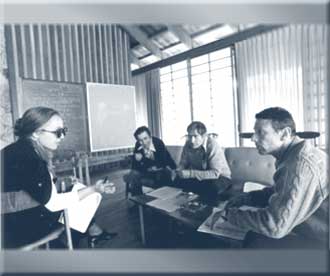Asilomar meeting

Asilomar meeting. February 1975. (L to R) Maxine Singer, Norton Zinder, Sydney Brenner, Paul Berg. With the invention of recombinant DNA (rDNA), scientists were faced with the daunting task of determining whether the new technology was safe. Was the ability to splice genes the biological equivalent of the atom bomb or the telescope? These concerns were addressed in 1975 at the Asilomar conference center in California, where scientists, lawyers, and the media gathered for grueling debate.
asilomar conference center,norton zinder,maxine singer,sydney brenner,atom bomb,biological equivalent,recombinant dna,paul berg,daunting task,genes,invention,new technology,telescope,scientists,lawyers
- ID: 15653
- Source: DNALC.DNAi
Related Content
15655. James Watson and Sydney Brenner (1975)
James Watson (L) and Sydney Brenner (R) at the Asilomar meeting, 1975.
15135. Reaction of young scientists to Asilomar, Victor McElheny
Former New York Times journalist Victor McElheny remembers the fears of young scientists.
16466. Biography 20: Matthew Stanley Meselson (1930- )
Matthew Meselson and Franklin Stahl invented the technique of density gradient centrifugation and used this to prove that DNA is replicated semi-conservatively.
15284. The media at Asilomar, Sydney Brenner
Sydney Brenner talks about his suggestion that the Press switch off their tape recorders at Asilomar.
15020. Possible dangers of recombinant DNA, Paul Berg
Paul Berg talks about possible dangers of recombinant DNA.
15654. Asilomar conference papers
"Asilomar Conference on Recombinant DNA Molecules" published in Science on June 6, 1975.
15024. The origin and utility of recombinant DNA, Paul Berg
Paul Berg discusses the usefulness of recombinant DNA to isolate and study genes.
15647. Paul Berg (1976)
Image of Paul Berg, Brooklyn-bred chemistry whiz. Known for his pioneering work in recombinant DNA, which won him a Nobel Prize in 1980.
15021. The moratorium letter regarding risky experiments, Paul Berg
In 1974, scientists in the field of recombinant DNA drafted a letter calling upon "scientists throughout the world" to suspend certain types of studies until hazards could be assessed. Paul Berg talks about the "Moratorium Letter."
835. Neuroethics and Neuroimaging
New technologies that permit us to observe the workings of the human brain and to influence its function also raise critical ethical and policy questions.












